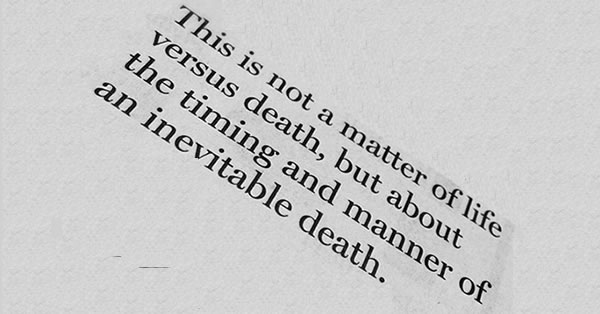Sadly Wellington woman Lecretia Seales died after finding out she was not successful in court, having spent her last days challenging our euthanasia laws. She wanted her GP to assist her death when she chooses, without getting prosecuted after the fact. The judge ruled that only a change in legislation could make euthanasia legal.
The right of a person to end their own life in a manner of their choosing seems like a no brainer, yet both John Key and Andrew Little agree that Parliament is unlikely to go there – the issue is too contentious. Ironic though that John Key is personally prepared to talk about euthanasing humans but won’t discuss euthanising unowned cats. Instead of letting this issue fade, Lecretia’s legacy should be the start of a bigger, much more important conversation about how we deal with the end of life.
Euthanasia is a tiny part of the end of life issue
The narrow medical definition of euthanasia is the practice of intentionally ending a life in order to end pain and suffering. This does not happen in New Zealand, hence the call for a law change. Of course when the subject of euthanasia comes up the concern is that doctors and families might start dispatching patients simply because they are an inconvenience, or that people will use it to end their own lives when they are not terminally ill. It should not be difficult to put protocols in place that cater for that.
The sort of circumstances where euthanasia could come into play are comparatively rare. As such, making euthanasia legal would not really make a difference to how most Kiwis die.
How can we all have a death with dignity?
The much bigger issue facing our health system is not when we consciously end our lives, but when should we stop offering the treatment that keeps many people alive a little longer. This is a much bigger, and more important issue: how we have a dignified death given limited healthcare resources.
We only have limited resources – docs, nurses, hospital beds and money – to treat people. People always want more healthcare than we can deliver (particularly when its free!), so rationing occurs. We like to think we have a health system that can treat everyone all the time but this is an illusion. Treatments are rationed, and people die as a result. Doctors are making these calls all the time, particularly in emergency departments.
End of life treatments are expensive and often pointless
In our book Health Cheque, we found that New Zealand wastes too much of our resources throwing the most expensive treatments at those already on death’s door. It is natural to want to rescue those that are closest to death, but we shouldn’t kid ourselves that this spending actually makes anyone live longer. It just makes us feel better that we tried everything.
This conscience cleansing comes at a cost – end of life treatment is a controversial and incredibly expensive part of our public health care system. A few years ago Counties Manakau DHB estimated that each person costs the health system more than $20,000 in their last year of life. That is an average figure, for some the cost runs in the hundreds of thousands of dollars.
If we are really interested in living longer, or helping the poor and needy, we should spend more of our precious resources on prevention rather than heroically trying to keep people alive for a few more weeks or months. There are several ways to achieve this.
In many cases investing in end of life care would be better
As individuals and families we need to talk about ‘advanced care planning’ – how basically we want to die. All medical treatments have a downside, and often treatment simply prolongs a patients agony, or worse the treatment can end up being more damaging than the condition.
In some cases, brave doctors, nurses, patients and families have an honest conversation about things, and decide that while treatment may be keeping the patient alive longer, it is causing un-necessary pain and is unlikely to restore a quality life. So treatment is ceased and the focus goes onto caring for the patient, rather than treating them. This common sense way of dealing with death is better for all involved, and saves taxpayer money too. Unfortunately these conversations are difficult to have, so they tend to be avoided and the madness continues.
But politicians won’t do this
Government could support this approach by ensuring that health spending goes on the treatments that will have the greatest health benefit. They could also channel more resources into end of life care, so that people could be offered a choice to receive care rather than endless operations. However, as Key and Little have admitted, politicians are too chicken to have the hard conversations. This is why we have suggested removing healthcare spending decisions from the hands of politicians. They set the goals, and healthcare experts can plan the best way to achieve those goals.
The time is ripe to build on Lecretia’s legacy and open this debate up from a narrow focus on euthanasia. We need to grow up, realise we aren’t immortal and start talking about a dignified death. Government needs to own up to the fact that rationing already occurs, and we can do it better. As individuals we need to start talking openly about the downsides of treatment, and at what point we don’t wish to receive more treatment to keep us alive.

